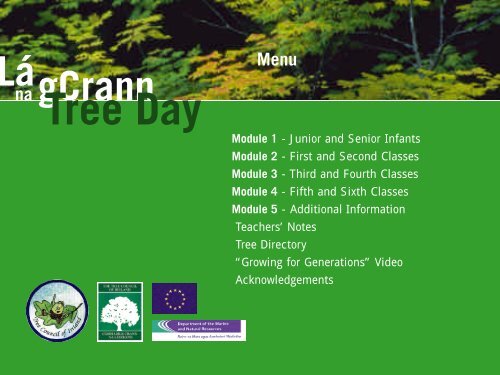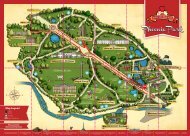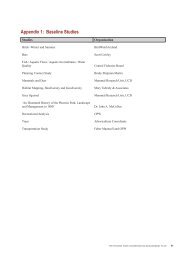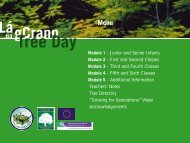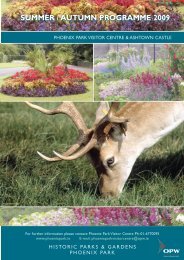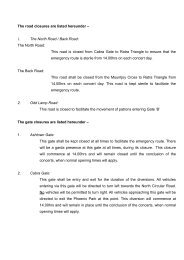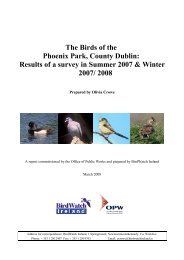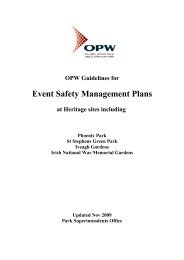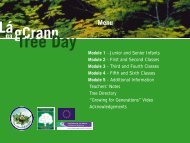Worksheets for 5th & 6th Class - Phoenix Park
Worksheets for 5th & 6th Class - Phoenix Park
Worksheets for 5th & 6th Class - Phoenix Park
Create successful ePaper yourself
Turn your PDF publications into a flip-book with our unique Google optimized e-Paper software.
á<br />
na gCrann<br />
Tree Day<br />
Menu<br />
Module 1 - Junior and Senior Infants<br />
Module 2 - First and Second <strong>Class</strong>es<br />
Module 3 - Third and Fourth <strong>Class</strong>es<br />
Module 4 - Fifth and Sixth <strong>Class</strong>es<br />
Module 5 - Additional In<strong>for</strong>mation<br />
Teachers’ Notes<br />
Tree Directory<br />
“Growing <strong>for</strong> Generations” Video<br />
Acknowledgements
A Woodland<br />
A woodland is a place where trees have been growing<br />
together <strong>for</strong> many years.<br />
As well as trees, there are other plants and animals in a woodland.<br />
There are four different layers in a woodland.<br />
The Canopy<br />
The canopy consists of the leafy tops of<br />
the trees. These leaves get the most<br />
sunlight.<br />
Birds build their nests here. Insects<br />
such as caterpillars, greenflies and<br />
leafhoppers live on the leaves.<br />
Squirrels live on the branches.<br />
The Shrub Layer<br />
The shrub layer consists of smaller<br />
trees and shrubs. These include<br />
holly, laurel and rhododendron.<br />
Bushes with berries such as<br />
hawthorn and blackberries are in<br />
this layer. These provide food <strong>for</strong><br />
blackbirds, thrushes and other birds.<br />
Canopy<br />
The Ground Layer<br />
Small flowering plants live in the ground<br />
layer. Typical woodland flowers are bluebells,<br />
primroses, foxgloves and arum lily. Ferns and<br />
ivy also grow on the woodland floor.<br />
Animals such as mice and shrews live here.<br />
Beetles and ants can also be seen in this layer.<br />
The Leaf Litter<br />
Leaves fall off deciduous trees in autumn and pile<br />
up on the ground under the trees. The name given<br />
to this collection of dead leaves on the woodland<br />
floor is leaf litter.<br />
Hedgehogs gather up bundles of leaves in holes at<br />
the bottom of trees. They burrow into them and<br />
curl up to hibernate there until spring.<br />
If you turn over heaps of leaves, you will<br />
find woodlice, millipedes, centipedes<br />
and earthworms underneath.<br />
Leaf Litter<br />
Ground<br />
Layer<br />
Shrub<br />
Layer<br />
Trees –Module Four – Worksheet 1
The Canopy Layer<br />
Jay<br />
In a woodland, trees provide food <strong>for</strong> insects,<br />
animals and birds. The leaves, flowers and<br />
fruits of trees are food <strong>for</strong> many different animals.<br />
Animals that eat plants are called herbivores.<br />
Animals that eat other animals are called carnivores.<br />
Each layer of a woodland has herbivores and carnivores.<br />
Bullfinch<br />
Birds eat flowers, nuts and berries. Bullfinches eat flower buds be<strong>for</strong>e they open.<br />
Blackbirds and thrushes eat fruit and berries. Jays eat acorns.<br />
Insects and other small creatures eat leaves.<br />
Caterpillars of butterflies and moths live on leaves.<br />
Leafhoppers and greenflies suck the juices of leaves.<br />
Greenfly<br />
Slugs and snails climb up the trunks to eat the<br />
leaves at night and go back down again during the day.<br />
Snail<br />
Carnivores<br />
Here are some<br />
carnivores in this layer.<br />
1 Ladybirds eat greenflies.<br />
2 Spiders catch leafhoppers.<br />
3 Robins eat caterpillars.<br />
Spider<br />
4 Sparrowhawks eat robins and caterpillars.<br />
Sparrowhawk<br />
Robin<br />
Ladybird<br />
Trees –Module Four – Worksheet 2
The Shrub Layer<br />
Finding Food<br />
Many of the leaf-eating creatures<br />
in the canopy layer, such as<br />
caterpillars and snails, eat the<br />
leaves in the shrub layer as well.<br />
There are often more berries<br />
and nuts in the canopy layer<br />
which are food <strong>for</strong> blus tits,<br />
great tits and chaffinches.<br />
Blue Tit<br />
Insect Eaters<br />
Insect eaters in this layer<br />
include wrens and<br />
long-tailed tits.<br />
Wren<br />
Treecreepers hunt <strong>for</strong><br />
insects in the cracks<br />
in the bark of trees.<br />
Wasp<br />
Treecreeper<br />
Wasps and hoverflies<br />
feed on smaller insects.<br />
They are carnivores.<br />
They are found in the<br />
shrub layer as well.<br />
Hoverfly<br />
Trees –Module Four – Worksheet 3
The Ground Layer<br />
Many animals which live in the ground<br />
layer come out at night to find their food.<br />
Large insects such as ground<br />
beetles eat smaller creatures.<br />
Pygmy shrews eat beetles.<br />
Badgers come into<br />
woodlands to eat berries<br />
and mushrooms, as well as<br />
worms, slugs and snails.<br />
Barn owls and<br />
long-eared<br />
owls hunt mice<br />
in woodlands<br />
at night.<br />
Hedgehogs eat insects and slugs.<br />
Trees –Module Four – Worksheet 4
The Leaf Litter<br />
Woodlice, earthworms and<br />
millipedes, inhabit this layer<br />
and eat dead leaves.<br />
Centipedes and spiders are<br />
carnivores which feed on<br />
woodlice, and millipedes.<br />
They run away very<br />
quickly when we<br />
turn over leaves<br />
to look <strong>for</strong> them.<br />
Trees –Module Four – Worksheet 5
➠ ➠<br />
Plants and Animals<br />
This word bank contains the<br />
names of some trees and plants<br />
found in a woodland.<br />
Plants<br />
The Canopy<br />
Animals<br />
Decide in which layer each tree<br />
or plant belongs. Then write its<br />
name in the correct box.<br />
Trees and Plants<br />
The Shrub Layer<br />
oak<br />
primrose<br />
Plants<br />
Animals<br />
brambles<br />
beech<br />
holly<br />
bluebell<br />
ash<br />
wild garlic<br />
fern<br />
ivy<br />
This word bank contains the<br />
names of some animals found in<br />
a woodland.<br />
Decide in which layer each<br />
animal belongs. Then write its<br />
name in the correct box.<br />
The Ground Layer<br />
Plants<br />
Animals<br />
Animals<br />
blackbird<br />
caterpillar<br />
hedgehog<br />
beetle<br />
squirrel<br />
ladybird<br />
badger<br />
robin<br />
wood louse<br />
mouse<br />
Plants<br />
The Leaf Litter<br />
Animals<br />
Trees –Module Four – Worksheet 6
Food Chains<br />
Construct a food chain <strong>for</strong> each layer in the <strong>for</strong>est.<br />
The Canopy<br />
The Shrub Layer<br />
The Ground Layer<br />
The Leaf Litter<br />
Trees –Module Four – Worksheet 7
Food Webs<br />
Every living thing is part of a food chain.<br />
Some animals eat a varied diet and <strong>for</strong>m parts of different food chains.<br />
Food chains linked in this way are called food webs.<br />
A Simple Food Chain<br />
➠<br />
Mouse<br />
➠<br />
Seed<br />
Owl<br />
A Food Web<br />
Herbivores are plant eaters.<br />
They are known as primary consumers.<br />
Carnivores eat other animals.<br />
They may eat more than one type of herbivore and are called<br />
secondary or tertiary consumers.<br />
Secondary consumers eat primary consumers.<br />
Tertiary consumers eat both primary and secondary consumers.<br />
Ladybird<br />
(S)<br />
Leaf<br />
Seed<br />
P Primary<br />
S Secondary<br />
T Tertiary<br />
Wren<br />
(S)<br />
Shrew<br />
(T)<br />
Greenfly<br />
(P)<br />
Mouse<br />
(P)<br />
Caterpillar<br />
(P)<br />
Sparrowhawk<br />
(T)<br />
Spider<br />
(S)<br />
Owl<br />
(T)<br />
Robin<br />
(T)<br />
Trees –Module Four – Worksheet 8
Food Webs<br />
Who eats what?<br />
Draw your own food web on this page.<br />
Use what you have learnt about the foods which birds and animals eat.<br />
Remember<br />
Herbivores – plant eaters – are primary consumers.<br />
Carnivores eat other animals. They can be either secondary or tertiary consumers.<br />
Secondary consumers eat primary consumers.<br />
Tertiary consumers eat both primary and secondary consumers.<br />
Trees –Module Four – Worksheet 9
Pollination<br />
Trees must produce flowers in spring so that they can make<br />
seeds in autumn.<br />
Flowers contain pollen which is a very fine powder.<br />
Pollen must be transferred from the male part of one flower to<br />
the female part of another flower so that seeds can <strong>for</strong>m.<br />
Types of flowers<br />
There are two types of flowers: blossoms (flowers with petals) and catkins.<br />
Horse Chestnut<br />
Hawthorn<br />
Blossoms<br />
Blossoms attract insects such as bees and butterflies which visit<br />
these flowers to collect nectar (flower juice). While doing this<br />
they become dusted with pollen.<br />
When they move on, the pollen they<br />
have picked up from one flower rubs<br />
off on the next flower. In this way, bees<br />
are very important in helping new seeds<br />
to develop and grow.<br />
Horse chestnut, cherry, hawthorn, apple and mountain ash<br />
trees have flowers which are pollinated by insects.<br />
Catkins<br />
Some trees use the wind to blow pollen from one flower<br />
to flower. Some trees have long catkins. As the catkins<br />
shake in the wind, the pollen is blown from tree to tree.<br />
Bee on<br />
Hawthorn<br />
These trees don’t need blossoms.<br />
Instead, their flowers are long<br />
catkins which are easily shaken<br />
by the wind.<br />
Hazel<br />
Oak<br />
Hazel, birch, alder and oak<br />
trees have catkins.<br />
Trees –Module Four – Worksheet 10
Pollination<br />
Male and female flowers<br />
The flowers described so far have male and<br />
female parts in the same flower.<br />
The male part produces the pollen and the<br />
female part makes the berry or seed.<br />
Holly<br />
Male<br />
Holly<br />
Female<br />
Some trees have male flowers only on one tree<br />
and female flowers only on another tree.<br />
Holly, willow and poplar have separate trees <strong>for</strong><br />
male and female flowers.<br />
The pollen from the male flowers<br />
is blown by the wind to the<br />
female flowers.<br />
Poplar<br />
Male<br />
Coniferous flowers<br />
Poplar<br />
Female<br />
Coniferous trees do not have flowers with petals.<br />
Their flowers are cones.<br />
The small male cones have the pollen. Thelarger female<br />
cones are on the same tree. The wind blows the pollen onto<br />
the female cones which is where the seeds develop.<br />
It is easy to identify male and female cones in spring when<br />
the pollen is ripe and it is blown by the wind.<br />
Female<br />
cones<br />
Male<br />
cones<br />
Trees –Module Four – Worksheet 11
Pollination<br />
To Do<br />
1 Collect some flowers in spring.<br />
Then look up tree flowers in a reference book on Trees.<br />
✶ White flowers grow on _____________________________________ .<br />
✶ Pink flowers grow on _____________________________________ .<br />
2 Collect some catkins. Beware of this activity if you suffer from allergies!<br />
Put the catkins in a vase. Put the vase on a sheet of white paper.<br />
The pollen will drop out onto the paper.<br />
✱<br />
Name the tree from which you collected the catkins?<br />
_____________________________<br />
✱ What colour is the pollen?<br />
_____________________________<br />
3 Some trees develop their leaves first, then their flowers.<br />
Some trees develop their flowers first, then their leaves.<br />
What have you observed?<br />
✱ __________________________________<br />
develops its flowers be<strong>for</strong>e its leaves.<br />
✱ __________________________________<br />
develops its flowers after its leaves.<br />
Trees –Module Four – Worksheet 12
How Trees Work<br />
Trees need light, air, heat and water in order to grow.<br />
They need sunlight to make food and oxygen.<br />
Humans need oxygen to live. We get it from trees and other plants.<br />
Making food and giving off oxygen is called photosynthesis.<br />
The oxygen is given off into the air by the leaves.<br />
The food is sent down through the bark of the tree to the roots.<br />
The bark is a very important part of a tree. If it is damaged,<br />
the tree may die.<br />
Leaves need water <strong>for</strong> photosynthesis. The water comes from<br />
rainfall. Trees need a lot of rain to grow and they cannot live in<br />
deserts. Water comes up from the roots, through the trunk of the<br />
tree under the bark, to the leaves.<br />
Photosynthesis experiments<br />
✔<br />
✔<br />
✔<br />
✔<br />
Plants need light. Energy <strong>for</strong> photosynthesis comes from sunlight.<br />
Plants need air. Plants take carbon dioxide from the air and give off oxygen.<br />
Plants need heat. Plants cannot grow at very low temperatures.<br />
Plants need water. They take it in through their roots.<br />
❋<br />
Water<br />
❋<br />
❋<br />
Water<br />
Food<br />
◆<br />
You will need…<br />
✸<br />
✸<br />
✸<br />
✸<br />
Five healthy potato plants in pots.<br />
Label the plants 1, 2, 3, 4, and 5.<br />
A black plastic bag<br />
A large, clear jar with a screw lid<br />
Access to a fridge<br />
1 2<br />
What you do…<br />
➨<br />
➨<br />
Place Plant 1 on a window sill in full light. Water it as required.<br />
Place Plant 2 on a window sill. Do not water it at all.<br />
➨ Water Plant 3 and place it in the black plastic bag.<br />
Seal the bag.<br />
3<br />
➨ Put Plant 4 in the jar. Water it and then screw on the<br />
lid tightly.<br />
4<br />
➨ Water Plant 5. Then put it into the fridge.<br />
This experiment is carried out over two weeks.<br />
Examine the plants at the end of each week.<br />
5<br />
Trees –Module Four – Worksheet 13
Results: Week 1<br />
Examine the plants at the end of Week 1.<br />
Plant 1<br />
Q What has happened to this plant?<br />
_____________________________________________________________________<br />
Q Why? ______________________________________________________________<br />
Plant 2<br />
Q What has happened to this plant?<br />
_____________________________________________________________________<br />
Q Why? ______________________________________________________________<br />
Plant 3<br />
Q What has happened to this plant?<br />
_____________________________________________________________________<br />
Q Why? ______________________________________________________________<br />
Plant 4<br />
Q What has happened to this plant?<br />
_____________________________________________________________________<br />
Q Why? ______________________________________________________________<br />
Plant 5<br />
Q What has happened to this plant?<br />
_____________________________________________________________________<br />
Q Why? ______________________________________________________________<br />
Trees –Module Four – Worksheet 14
Results: Week 2<br />
Examine the plants at the end of Week 2.<br />
Plant 1<br />
Q What has happened to this plant?<br />
_____________________________________________________________________<br />
Q Why? ______________________________________________________________<br />
Plant 2<br />
Q What has happened to this plant?<br />
_____________________________________________________________________<br />
Q Why? ______________________________________________________________<br />
Plant 3<br />
Q What has happened to this plant?<br />
_____________________________________________________________________<br />
Q Why? ______________________________________________________________<br />
Plant 4<br />
Q What has happened to this plant?<br />
_____________________________________________________________________<br />
Q Why? ______________________________________________________________<br />
Plant 5<br />
Q What has happened to this plant?<br />
_____________________________________________________________________<br />
Q Why? ______________________________________________________________<br />
Trees –Module Four – Worksheet 15
Competing and Adapting<br />
Plants and animals have to adapt to compete <strong>for</strong> food and light.<br />
✱ All plants in a woodland need light to grow. Trees compete <strong>for</strong> light and the<br />
tallest trees get the most. So the fastest growing trees do best.<br />
✱ Some plants are specially suited to growing in a woodland. They are adapted<br />
to make the most of the light they get.<br />
✱ Ground flowers, such as primroses and bluebells, flower early in the year<br />
be<strong>for</strong>e the leaves come on the trees. More light gets through to the woodland<br />
floor at this time and there is enough light <strong>for</strong> these plants to flower.<br />
✱ Some plants are adapted to climb up towards the light using<br />
other plants as props. They then have light all the year and<br />
do not have to flower as early. Honeysuckle, which flowers<br />
in August and ivy, which flowers in November, are examples<br />
of these plants.<br />
✱ Animals also compete and adapt in a woodland.<br />
Herbivores that feed on leaves cannot move very fast<br />
to escape from their enemies. They use camouflage –<br />
being the same colour as their food – to hide from their<br />
enemies and they stay very still. Some caterpillars are green<br />
and can’t be seen easily on green leaves. Other caterpillars are brown<br />
and look like twigs.<br />
Some butterflies have eye spots on their wings which birds peck, thinking<br />
they are eyes, and the butterfly escapes with just a hole in its wing.<br />
Some animals have an unpleasant taste so they don’t need to<br />
hide. Ladybirds are red to warn birds not to eat them as<br />
they contain acid. Bees and wasps have stings which<br />
make them dangerous to eat. Their yellow and black<br />
colours also warn off birds. Hoverflies are the same colours as bees and<br />
Wasp<br />
wasps. Although they do not have stings, birds are afraid to eat them.<br />
✱ Many woodland animals feed at night. Snails and slugs feed at night<br />
because they would get dried up in the heat of the sun during the day.<br />
Beetles and spiders hunt at night so they won’t be seen by birds. Bats<br />
Hoverfly<br />
catch moths in woodlands at night. They have developed a sonar system<br />
which allows them to fly and locate their prey without crashing into trees.<br />
Like owls, bats are able to see in very dim light.<br />
To Do<br />
What is a sonar system? Can you find out?<br />
(Clue: sound waves – very high pitch.)<br />
What is an echo?<br />
Discuss ‘as blind as a bat’.<br />
Is it likely that bats would fly into people’s hair?<br />
Trees –Module Four – Worksheet 16
Recycling<br />
When we walk through a woodland in<br />
October and November, we can kick<br />
through great mounds of leaves.<br />
When we walk through a woodland in<br />
June, the mounds of leaves have gone.<br />
What happens to the leaves?<br />
Where do they go?<br />
Dead leaves provide food <strong>for</strong> special<br />
kinds of plants and animals called<br />
decomposers.<br />
There are both plant and animal<br />
decomposers.<br />
Plant Decomposers<br />
Plant decomposers are fungi.<br />
Fungi are mushroom-like plants that grow on<br />
the dead leaves. They are not green, so they<br />
cannot make their own food Instead, they<br />
use the dead leaves as food. In doing so,<br />
they cause the leaves to decompose and<br />
disappear.<br />
Fungi grow among the dead leaves all year.<br />
In autumn time, they fruit and send up mushroom-like caps.<br />
There are many different varieties of fungi<br />
and autumn is a good time to see them.<br />
Fungi also grow on dead logs and under<br />
dead bark.<br />
Trees –Module Four – Worksheet 17
➩<br />
Material Recycling<br />
Animal Decomposers<br />
Animal decomposers are also hard at work<br />
in the leaf litter.<br />
Woodlice and millipedes get all their<br />
food from dead leaves and dead timber.<br />
Earthworms pull leaves down into the soil<br />
and eat them underneath the surface.<br />
If you collect a handful of soil and dead<br />
leaves, you will see these animals at work.<br />
Animal decomposers and fungi break<br />
leaves down completely.<br />
The Cycle of Life<br />
The food made by living leaves is used up by the decomposers. Leaves also contain nitrogen,<br />
phosphorous and other minerals.<br />
These dissolve in rainwater and go back into the soil<br />
where they are taken in by the roots of nearby trees.<br />
The minerals are sent up to the leaves and become part<br />
of the living tree once again.<br />
➩<br />
Nutrients<br />
are sent to<br />
the leaves<br />
through<br />
the trunk.<br />
Animals decomposers break down leaves.<br />
➩<br />
Decomposers<br />
are very<br />
important in<br />
the woodland’s<br />
Cycle of Life.<br />
➩<br />
➩<br />
Nitrogen, phosphorous and other<br />
minerals return to the soil.<br />
➩<br />
➩<br />
➩<br />
These nutrients are<br />
taken in by the roots.<br />
➩<br />
Trees –Module Four – Worksheet 18
To Do<br />
Mushrooms and toadstools are common names <strong>for</strong> fungi.<br />
These plants do not have flowers. They grow from spores that fall from the<br />
fruiting cap.<br />
You can make a spore print from a cap you have collected.<br />
You will need…<br />
A mushroom-type fungus<br />
A page of white or coloured paper<br />
What you do…<br />
✱ Carefully remove the stalk from the cap.<br />
✱ Put the cap on your page.<br />
✱ Leave <strong>for</strong> two days.<br />
The spores will fall down onto the page in the same arrangement as they were in the cap.<br />
Remove the cap and you will see the spore print.<br />
What colour were the spores?<br />
______________________________<br />
Make your own Leaf Mould<br />
Leaf mould makes excellent peat-free compost. It’s free and easy to make and use. You can use<br />
it to improve the soil in your garden and as a seed compost.<br />
✱<br />
✱<br />
✱<br />
Hammer four posts into the ground. Make a cage by stretching a length of chicken wire<br />
mesh or plastic garden mesh around the four posts.<br />
You may also use a large black plastic bag, with a few holes in the bottom to drain away<br />
excess water.<br />
Fill the container with soggy leaves (collected after a rain shower). Push them down firmly<br />
to compact them. You may use leaves from any deciduous tree. Leaves<br />
from conifers and other evergreens acidify the leaf mould. This is<br />
an advantage if you have acid-loving plants.<br />
✱ Add some grass clippings (not more than a quarter).<br />
✱ Shred the leaves if you wish to speed up decomposition.<br />
After a year, your pile will have sunk down considerably<br />
and the leaves will be partially rotted. This could be dug<br />
into the soil as it is.<br />
However, it is recommended that you leave the leaf mould to<br />
rot or decompose <strong>for</strong> another year. You will have a much finer<br />
product. You can use your own home-made compost instead of<br />
peat compost. You are now actively helping to conserve our bogs!<br />
Trees –Module Four – Worksheet 19
Conservation<br />
It is important to conserve our woodlands. They are<br />
important in our lives <strong>for</strong> several reasons. If trees are needed<br />
<strong>for</strong> timber and firewood, they should be replanted so that new<br />
trees will take their place and the woodland will continue.<br />
✷<br />
Trees are a source of timber <strong>for</strong> furniture and building.<br />
They also provide the raw material <strong>for</strong> paper, cardboard,<br />
fibreboard and wood chip. In order to have a good<br />
supply of timber, <strong>for</strong>ests of fast-growing<br />
trees are planted in Ireland. These are<br />
evergreen conifers such as sitka spruce, fir and pine.<br />
✷ Trees are a source of firewood. People use<br />
firewood to keep warm and to cook. We do not<br />
use much timber in this way in Ireland. We<br />
use electricity instead, which is made from oil,<br />
coal, and water power, or we use natural gas.<br />
In many countries, people use timber <strong>for</strong> cooking as they have no<br />
other fuel. In Africa, Asia and South America, <strong>for</strong>ests are being cut<br />
down <strong>for</strong> firewood and <strong>for</strong>ests are very scarce around cities<br />
and towns. They are not being replanted in these areas.<br />
✷ Woodlands are homes <strong>for</strong> plants and animals that cannot live anywhere<br />
else. In Ireland, squirrels, pine martens, jays, treecreepers<br />
and purple hairstreak butterflies live in woodlands only.<br />
Many plants such as wild garlic, primroses and bluebells are<br />
woodland plants. In order to keep these plants and animals in<br />
Ireland, we must have woodlands.<br />
Bluebells<br />
Primroses<br />
Wild Garlic<br />
Trees –Module Four – Worksheet 20
Conservation<br />
To Do<br />
The following is a list of the best and most important woodlands in Ireland.<br />
They are mostly deciduous woods except <strong>for</strong> one which is mixed.<br />
They are important because they are on sites that have been wooded since the Ice Age.<br />
Animals and plants in these woods are typical of a native woodland.<br />
Can you mark them on the map?<br />
Use a detailed map of Ireland to find the exact location of each wood.<br />
Put the number of each woodland into the correct county on Worksheet 22.<br />
1 Glenomera Woods, The Burren, Co. Clare<br />
2 Glengarriff Woods, Co. Cork<br />
3 Glenveagh Woods, Co. Donegal<br />
4 Ardnamona Wood, near Lough Eske, Co. Donegal<br />
5 Derryclare Wood, Co. Galway<br />
6 Killarney Woodlands, Co. Kerry<br />
7 Uragh Woods, Co. Kerry<br />
8 Corballis Woods, Co. Kildare<br />
9 Abbeyleix Woods, Co. Laois<br />
10 Lough Gill Woods, Co. Leitrim<br />
11 Old Head Woodland, Co. Mayo<br />
12 Rahugh Ridge Woods, Co. Offaly/Westmeath<br />
13 Charleville Woods, Co. Offaly<br />
14 St. John’s Wood, Co. Roscommon.<br />
15 Bonet Wood, Co. Sligo<br />
16 Union Wood, Co. Sligo<br />
17 Cornalack Wood, Co. Tipperary (mixed)<br />
18 Knockasteen Wood, Co. Tipperary<br />
19 Portlaw Woods, Co. Water<strong>for</strong>d<br />
20 Nire Valley Woods, Co. Water<strong>for</strong>d<br />
21 Crookedwood, Co. Westmeath<br />
22 Long Hill Wood, Co. Westmeath<br />
23 Killoughrim Forest, Co. Wex<strong>for</strong>d<br />
24 Glendalough, Co. Wicklow<br />
25 The Glen of the Downs, Co. Wicklow<br />
26 Powerscourt, Co. Wicklow<br />
27 Rathdrum Woods, Co.Wicklow<br />
Trees –Module Four – Worksheet 21
Woodlands<br />
Put the number of<br />
each woodland into<br />
the correct county.<br />
Donegal<br />
Derry<br />
Antrim<br />
Tyrone<br />
Sligo<br />
Mayo<br />
Galway<br />
Clare<br />
Limerick<br />
Roscommon<br />
Leitrim<br />
Fermanagh<br />
Long<strong>for</strong>d<br />
Armagh<br />
Cavan<br />
Louth<br />
Westmeath<br />
Offaly<br />
Laois<br />
Tipperary<br />
Kilkenny<br />
Carlow<br />
Meath<br />
Kildare<br />
Down<br />
Dublin<br />
Wicklow<br />
Wex<strong>for</strong>d<br />
Kerry<br />
Cork<br />
Water<strong>for</strong>d<br />
How many of the woodlands are in<br />
Leinster? Ulster? Munster? Connacht?<br />
How many counties have no important woodlands left?<br />
Trees –Module Four – Worksheet 22
Rain Forests<br />
Trees are not just important as homes <strong>for</strong> wildlife. Forests<br />
are also very important to this whole planet.<br />
The most important area of <strong>for</strong>est in the world is the<br />
tropical rain <strong>for</strong>est. Rain Forests occurs in a belt all<br />
around the world at the Equator.<br />
Half of all the species of animals and plants in the world live<br />
in the rain <strong>for</strong>ests.<br />
The climate of the world is affected by these rain <strong>for</strong>ests.<br />
During photosynthesis, trees absorb carbon dioxide from the<br />
air and release oxygen.<br />
Great amounts of carbon dioxide are stored in the<br />
trees of a tropical rain <strong>for</strong>est. If these trees are cut<br />
down and burned, the carbon dioxide goes back<br />
into the atmosphere.<br />
An increase in the amount of carbon dioxide in the<br />
atmosphere causes the greenhouse effect.<br />
To Do<br />
Rain <strong>for</strong>ests occur in South America, West Africa<br />
and Asia. Find them on a globe or in an atlas.<br />
Q<br />
Name one country in each of these continents<br />
where rain <strong>for</strong>ests occur.<br />
South America<br />
Africa<br />
Asia<br />
________________________________<br />
________________________________<br />
________________________________<br />
The Greenhouse Effect<br />
Carbon dioxide in the atmosphere acts like a great<br />
greenhouse around the planet.<br />
It absorbs the heat that comes from the sun and traps it, so<br />
that it cannot be reflected back into space.<br />
The more carbon dioxide there is in the atmosphere, the<br />
warmer the earth will become.<br />
As this happens the climate of the world will change, the<br />
polar ice-caps will melt around the edges, and sea levels<br />
will rise causing flooding in coastal areas.<br />
Tropical <strong>for</strong>ests should not be cut down and burnt.<br />
Trees –Module Four – Worksheet 23
Trees and Climate<br />
The destruction of tropical rain <strong>for</strong>ests affects the<br />
world’s climate in another way.<br />
The areas where rain <strong>for</strong>ests occur are very hot<br />
and very wet because they are along the equator.<br />
The heavy rainfall trickles gently through the<br />
thick, leafy canopy and falls lightly on the<br />
<strong>for</strong>est floor.<br />
When the <strong>for</strong>ests are removed, the<br />
heavy rain falls directly on to the<br />
ground and washes away the soil.<br />
This causes flooding and landslides<br />
and makes surrounding areas unsafe<br />
<strong>for</strong> people to live in.<br />
Half of the world’s rain <strong>for</strong>ests have<br />
already been destroyed. Further<br />
destruction of rain <strong>for</strong>ests must stop if<br />
these bad climatic effects are to be halted.<br />
Conservation<br />
People who wish to conserve rain<br />
<strong>for</strong>ests should not buy mahogany<br />
or teak unless it comes from areas<br />
where replanting is taking place.<br />
The governments of the countries<br />
where the rain <strong>for</strong>ests occur should<br />
be asked to set up nature reserves<br />
in tropical rain <strong>for</strong>ests. This is<br />
happening in Brazil in South<br />
America.<br />
Dublin Zoo is breeding Golden<br />
Lion Tamarin monkeys <strong>for</strong><br />
reintroduction into these reserves.<br />
Trees –Module Four – Worksheet 24
Food from Plants<br />
Word Search<br />
pineapple<br />
orange<br />
bean<br />
The Word Search contains the names<br />
of food and drinks that come<br />
from plants.<br />
Can you find them all?<br />
banana<br />
lemon<br />
avocado<br />
peanut coconut pepper<br />
nutmeg chewing gum tea<br />
coffee cocoa chocolate<br />
c o c o a v o c a d o b b<br />
c h i l e c c o m f r a e<br />
a c e p t o h f e f a n a<br />
e h l w o f i f s s n p c<br />
l o i n i e l e t t g g o<br />
p c m e e n i e o h e v c<br />
p o t b e r g r p m v o o<br />
a l o p e l v g t i l n n<br />
e a t p i a a u u l o i u<br />
n t p m a e n m t m i h t<br />
i e b a n a n a e a o h c<br />
p e a n u t m l o n u t c<br />
Trees –Module Four – Worksheet 25
Tree Planting<br />
Trees are living plants – they mature, get old and<br />
die, even without human interference.<br />
When trees that die, they are replaced naturally<br />
by trees that grow from seeds in the woodland.<br />
If we want to use trees <strong>for</strong> timber, furniture,<br />
firewood and other things, we must plant trees to<br />
replace the ones we have felled. As we have so<br />
little woodland in Ireland (only 7%), we should<br />
plant far more trees than we cut down.<br />
Deciduous trees – trees that lose their leaves in<br />
winter – are our native trees.<br />
If we plant these, we will be providing more homes and food <strong>for</strong> the birds, animals and<br />
insects that already live here.<br />
To Do<br />
1 Survey your school grounds to see if it would be possible to plant trees.<br />
2 Collect seeds from native trees in the autumn.<br />
3 Plant the seeds in milk cartons and look after them <strong>for</strong> a year.<br />
4 Plant out the young trees in the chosen place.<br />
A hedge planted with ash, hazel and hawthorn<br />
is much more valuable to Irish wildlife<br />
than a hedge of Leyland cypress, privet<br />
or box.<br />
Growing native trees is very easy. Seeds<br />
should be collected in autumn and either<br />
kept moist over the winter <strong>for</strong> planting in<br />
spring or planted indoors immediately.<br />
One-litre milk cartons are good containers<br />
<strong>for</strong> tree seeds. They are biodegradable and<br />
can be inserted directly into the soil.<br />
When the trees in the pots are one year old, plant them out in the place where they are to<br />
grow. The milk carton will break down when it is placed in the soil and the tree will spread<br />
its roots. You can plant your classroom trees all together in the school grounds to <strong>for</strong>m a<br />
woodland or in a line to <strong>for</strong>m a hedge.<br />
After Care<br />
Young trees must be kept free from weeds and watered well during their first year in the soil.<br />
Trees –Module Four – Worksheet 26
Woodland Field Trip<br />
There are four layers in a woodland. Identify and name four plants in each layer.<br />
The Canopy<br />
Four trees<br />
1 ____________________________<br />
2 ____________________________<br />
3 ____________________________<br />
4 ____________________________<br />
The Shrub Layer<br />
Four shrubs or smaller trees<br />
1 ____________________________<br />
2 ____________________________<br />
3 ____________________________<br />
4 ____________________________<br />
The Ground Layer<br />
Flowers or small plants<br />
1 ____________________________<br />
2 ____________________________<br />
3 ____________________________<br />
4 ____________________________<br />
The Leaf Litter<br />
Identify some of the leaves on the ground.<br />
1 ____________________________<br />
2 ____________________________<br />
3 ____________________________<br />
Trees –Module Four – Worksheet 27
Woodland Field Trip<br />
Finding Animals<br />
Canopy Beating<br />
Do this to find the small animals that live on<br />
the leaves of a tree.<br />
You will need…<br />
an open umbrella<br />
What to do…<br />
☛ Two people should hold the umbrella by the edges,<br />
upside-down under the tree.<br />
☛ A third person then firmly shakes the branches over the umbrella.<br />
☛<br />
☛<br />
The insects and small creatures living on the leaves will fall into the umbrella.<br />
Take the umbrella away and look at what’s in it!<br />
What you will see<br />
✱<br />
✱<br />
✱<br />
✱<br />
There will be leaves and twigs in the umbrella as well as animals.<br />
The carnivores that live by catching other animals will run under the leaves.<br />
They include spiders and ladybirds.<br />
Herbivores such as caterpillars, greenfly and leaf hoppers won’t move.<br />
Flies and bees that were just resting on the leaves will fly away.<br />
Observation<br />
To see larger animals such as birds, divide into<br />
groups of two and stay quiet <strong>for</strong> at least 10 minutes.<br />
Note what you see and hear.<br />
Examine the trunk closely to see if there are any<br />
animals in the cracks in the bark. A torch could help<br />
<strong>for</strong> this task.<br />
Trees –Module Four – Worksheet 28
Woodland Field Trip<br />
Finding Animals<br />
Pitfall Traps<br />
These are traps set in the ground to catch animals that move over the ground at night.<br />
What to do…<br />
You will need a jar and a trowel.<br />
✱ Dig a hole under the tree. Put the jar right up to its<br />
neck in the hole.<br />
✱ Smooth off the soil so that the open jam jar is exactly<br />
flush with the level of the soil.<br />
Small animals moving over the ground at night<br />
will fall in and won’t be able to get out again<br />
because of the smooth sides.<br />
You can catch ground beetles in this way.<br />
Try baiting your pitfall traps with bits of meat<br />
or banana to see if your catch varies.<br />
Return all creatures to the wild after observing them!<br />
Leaf Litter<br />
If you look under leaves and under big stones or rotting timber, you will find animals that<br />
break down dead leaves (decomposers).<br />
Look out <strong>for</strong> woodlice, millipedes and earthworms.<br />
Faster moving animals such as centipedes and spiders are carnivores. They eat the<br />
decomposers.<br />
Snails and slugs which also might be here are resting and hiding from birds.<br />
They feed on vegetation at night.<br />
Trees –Module Four – Worksheet 29
Scavenger Hunt<br />
Take this list with you on a field trip. Identify all the things that are listed below.<br />
You may be able to collect some items if you find them on the ground.<br />
1 A hawthorn leaf<br />
2 A berry<br />
3 A wind-dispersed seed<br />
4 An animal from the bark of a tree<br />
5 A herbivore<br />
6 A feather<br />
7 Three pieces of litter<br />
8 A fungus<br />
9 A lichen from the trunk of a tree<br />
10 A leaf that is not green<br />
11 A carnivore<br />
12 A wild flower<br />
13 A nut<br />
14 A fern<br />
15 Something unusual<br />
Notes<br />
Trees –Module Four – Worksheet 30
A Nature Trail<br />
Make a Nature Trail<br />
Nature trails are made by people who know lots about the area.<br />
Make a nature trail in a wood that your class or a younger class will enjoy.<br />
What To Do<br />
✔<br />
✔<br />
✔<br />
✔<br />
Decide on a number of stops on the trail, perhaps six.<br />
Identify something interesting at each stop.<br />
Draw a map and mark down where each stop is located.<br />
Make field notes <strong>for</strong> the nature trail.<br />
Stop One<br />
Use Graphics<br />
Include graphics to illustrate the nature trail.<br />
➠ ➠ ➠ ➠ ➠<br />
Stop Two<br />
Stop Three<br />
Stop Four<br />
Stop Five<br />
Stop Six<br />
Eyes when you are asked to look at things.<br />
Ears when you have to listen.<br />
A Pen or Pencil when you are to write things down.<br />
Footsteps when you walk<br />
from one place to another.<br />
A Hand to feel things.<br />
A Nose when there is an interesting smell.<br />
and so on…<br />
Trees –Module Four – Worksheet 31


